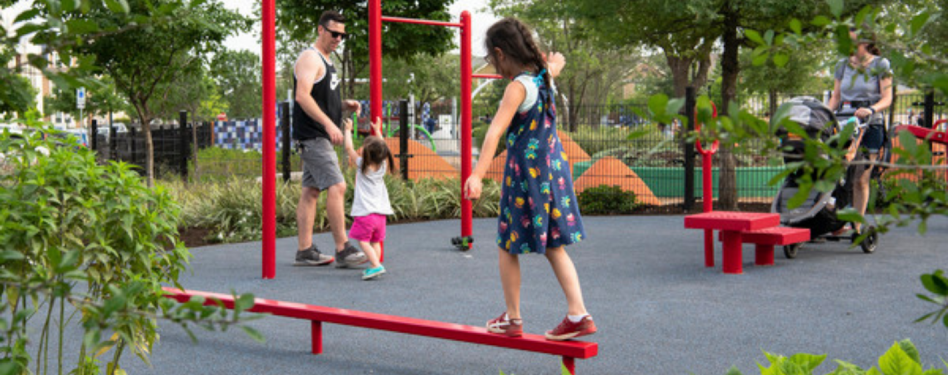
Photo credit: Brandon Huttenlocher/Design Workshop
In Austin, Texas, the Mueller neighborhood project was one of the first to achieve LEED for Neighborhood Development certification. Now, Mary Elizabeth Branch Park is providing residents with a newly SITES certified place to gather and play – making Mueller the first project to combine these two rating systems in the world.
Austinites may be familiar with the Mueller name, but not as many know that the neighborhood was carefully designed to be a beacon of sustainable development through a partnership between the City of Austin and Catellus Development Corp. Beginning in 2004, this neighborhood began construction on a former airport site with the goal of creating a sustainable, transit-oriented, mixed-use and mixed-income addition in the heart of the city. And they certainly achieved it. As of mid-2021, Mueller is home to five LEED Platinum certifications, nine LEED Gold certifications, and seven silver LEED certifications with more planned, along with their overarching LEED for Neighborhood Development Gold certification.
Getting to this point took coordination and creativity from a league of stakeholders. A driving force behind the LEED ND certification was Gail Vittori, a LEED Fellow, former GBCI and USGBC Boards’ chair and member, and Co-Director of the Center for Maximum Potential Building Systems (CMPBS) in Austin since 1979. A seasoned veteran of LEED projects, she was instrumental for the LEED Gold and SITES certified Dell Seton Medical Center at The University of Texas and a number of LEED certified projects in the U.S. and abroad with a specific focus to advance health-promoting strategies.
Gail encouraged the Mueller team to apply for the pilot program of LEED for Neighborhood Development, noting that the rating system would provide a concrete, actionable guide to meet their ambitious sustainability goals. “LEED sparks opportunities that might otherwise not be on the table because it leads to a credit and points,” explained Vittori. “It validates emerging concepts, supported by a transparent process that enlists subject matter experts and public comment.”
After riding out the recession in 2009, the Mueller team persisted, eventually achieving LEED for Neighborhood Development Gold certification, and becoming the largest Stage 3 LEED ND Pilot project Gold certified in the world, From creative solutions like solar panels and photovoltaic outdoor art, to a commitment to native vegetation and trees and an extremely effective district-scale storm water management system, to diverting more than 63,000 tons of construction and demolition debris from landfills as of 2016, the community approached their sustainable commitments holistically. Mueller is now home to more than 20 LEED certified buildings, with 25 percent of Mueller’s residences participating in an ambitious affordable housing program, ensuring that a diverse array of residents can enjoy the health benefits of a green, sustainable and healthy home.
After witnessing the powerful benefits of LEED certification in the neighborhood for several years, it was evident that green certifications were a positive step for Mueller. That’s why the team behind Mueller’s Mary Elizabeth Branch Park pursued SITES certification for sustainable landscape development when it was time to break ground in 2017.
Mary Elizabeth Branch Park has something for everyone: a playground, waterscape, dog run, volleyball courts, a hillside viewing area and an expansive open lawn, with care taken to provide enjoyable areas for all age groups. And as the project team attempted to ensure it would also be sustainable, the numerous synergies between LEED ND and SITES made the adoption of the new rating system run more smoothly.

Photo credit: Brandon Huttenlocher/Design Workshop
“Applying SITES strategies to the project had a direct impact on the design and distribution of program elements,” explained Claire Hempel of Design Workshop, the team hired by Catellus to complete the park. “Branch Park has created nature where there once was none. Over 200 trees were planted on a 3.5-acre park site that was former airport runway. The introduction of trees, plants and places for people promotes physical activity, restorative experiences and social interaction.”
As a previously developed site with few ecological resources to preserve, the park’s sustainability maneuvers focus on detailed product and material selection, efficient stormwater management, and dense, healthy vegetation. It is also now home to the city’s most popular farmers’ market, with nearly 100 local and regional vendors. In addition to advancing the park’s ecological goals, these decisions create a unique, regionally appropriate civic space. The project not only features high levels of recycled content, but most of the project’s materials are sourced from within 500 miles of the site, using native stone to replicate the Texas Hill Country landscape in which the park is situated. Many of those materials, including pewter and charcoal, function as permeable pavers that are part of the project’s stormwater management plan.

Photo credit: Brandon Huttenlocher/Design Workshop
Mueller’s original focus on native vegetation and re-greening paid off well: the park also includes 90 percent native vegetation, and their original sustainable site goals transitioned cleanly to the new park. “As elsewhere in the project, the plants used in the vegetative absorption zones are native and locally appropriate, both reducing the need for (and impact from) chemical pesticides and fertilizers and echoing the project’s regional identity,” noted the Design Workshop team. “Despite the extensive gardens in the park, less water is needed because of the use of drought-tolerant and adapted species. Native tree species advance this place-based narrative while providing shade for the site’s users and habitat for its dwellers.”
This cleverly designed park is a microcosm of Mueller’s overarching mission: one that works with the natural environment rather than against it, providing a safe, healthy, and sustainable neighborhood to call home. Through their LEED ND and SITES certifications, the Mueller team – and past and present team members like Vittori – continue to strive toward sustainable excellence. In Vittori’s words, “I can’t think of anything that is more rewarding than this project.”
Learn more about LEED for Neighborhood Development, SITES certification, and the synergies between the two rating systems to see if they could be right for your project.
